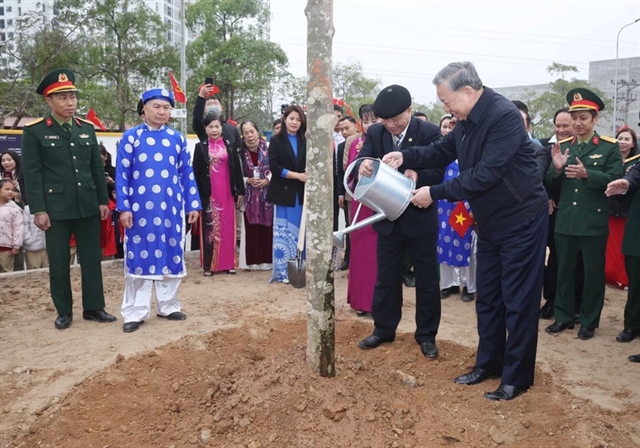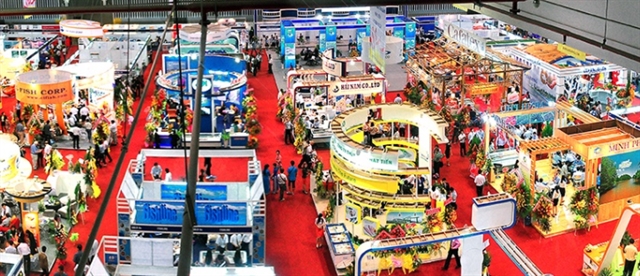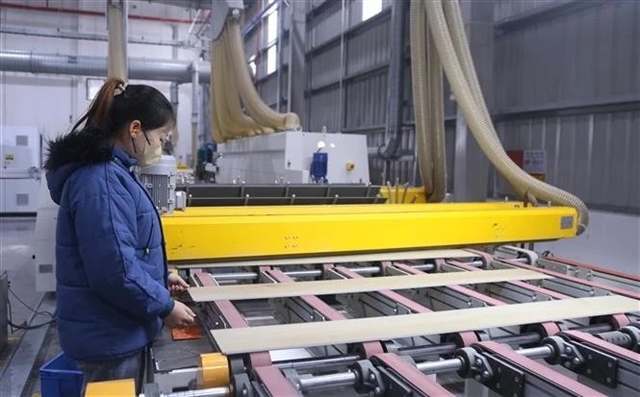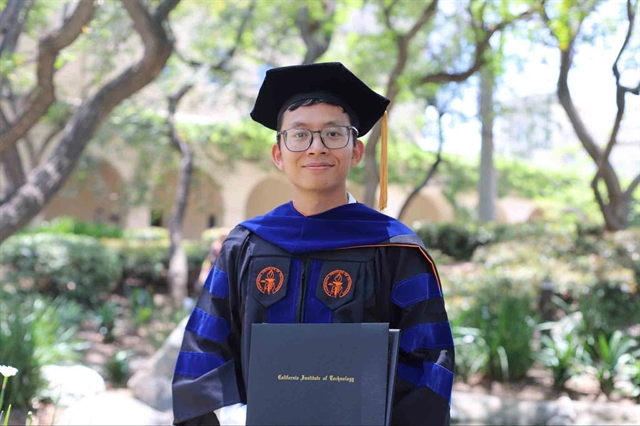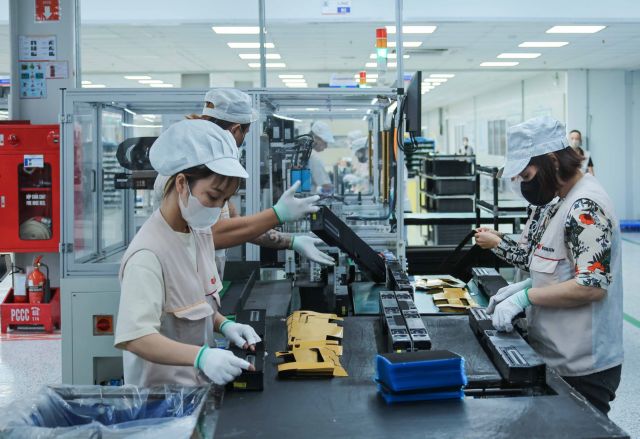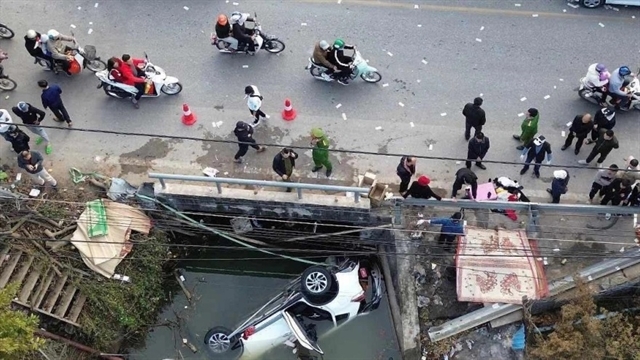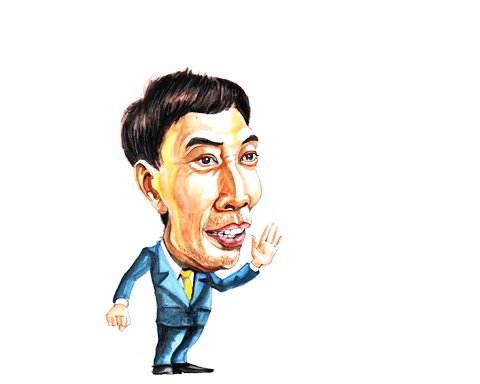

An area near a bridge over the Red River was once a mess. Now, artists are fixing it up. They have used things like old plastic bottles and scrap-metal to create artwork.
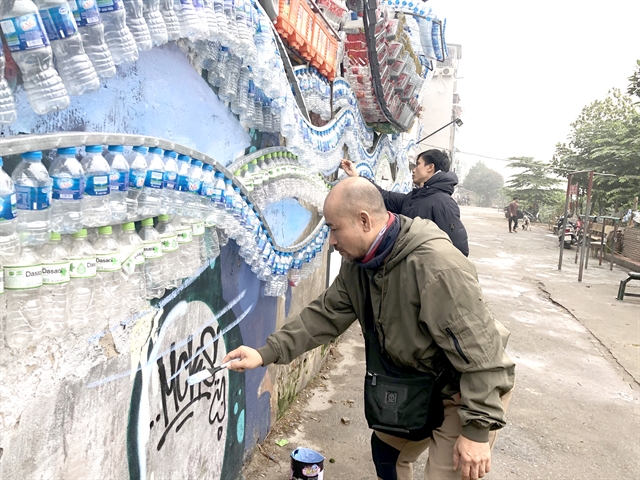
|
| Vũ Xuân Đông and one of his colleagues work on the installation work titled Boat. VNS Photo Lê Hương |
By Lê Hương
An area in Hà Nội's Phúc Tân Commune by the Red River has been revitalised in recent days after a group of artists decided to install art in the former dumping ground.
The group is trying to turn the area at the foot of Long Biên Bridge, which is mostly frequented by homeless people and scrap-iron dealers, into an attractive spot for local youths and tourists.
Sixteen artworks made from recycled materials have been placed along the old wall, which was built 20 years ago to prevent people from encroaching on the river bank.
Among the most eye-catching pieces, the installation titled Thuyền (Boat) by Vũ Xuân Đông made from 10,000 used oil bottles seems to float along the old wall full of graffiti.
“This project calls for works using recycled materials,” he told Việt Nam News. “I gathered used plastic bottles and cans and asked other people to help to collect them as well.”
“For a green, clean and beautiful world, I would like to encourage people to join hands to save the environment,” Đông said.
“And these thrown away materials can still be used to make artworks for local audiences,” he added.
Art researcher Trần Hậu Yên Thế contributed the installation entitled Bức Tường Danh Vọng (The Wall of Fame) with images of metal windows and doors of old Hà Nội houses.
“In some of my long-term research on the effect of Long Biên Bridge on Hà Nội’s landscape, I have realised the important role of metal in architecture decorations,” he said.
“This work reflects houses which are disappearing. They have either completely disappeared or have faded in contemporary life. These images reflect doors, balconies, windows in houses of various important figures in Hà Nội in the past. They are poets, painters and building contractors who have made considerable contributions to the city.”
Thế said he wanted to describe a legend when someone kisses a frozen ruined city, the city would be awakened.
“This is a fiction that the once glorious Hà Nội will rejuvenate,” he said. “The same as how this space near Long Biên Bridge will be livened up by the project.”
Acting as the curator for the project, artist Nguyễn Thế Sơn, a lecturer from the Hà Nội Fine Arts University, was asked by the Hoàn Kiếm District’s People’s Committee to turn the old dumping area into an artful destination.
They spent more than a month turning the dusty wall overlooking the river into an artful space. Running along the wall is a bumpy cement road full of rubbish and dog shit.
“We have tried to co-ordinate with the local community from the beginning,” he said. “We introduced the project, artists and works to locals. They were very happy and excited about the artworks. Most of the people think this is the backside of the city. Not only residents here, but people from other areas in the city also bring rubbish to dump here.
“That’s why we try to use rubbish and recycled materials in our works,” he said. “We encourage locals to collect used bottles and other materials for us to use in this project. We hope to change people’s attitude towards the environment. Many people have joined our project from the beginning. They can be proud of the artworks and their living environment now.”
Sơn himself has two installations at the site, named Gánh Hàng Rong (Street Hawkers) and Phù Điêu Đông Dương (Bas-Relief of Indochina).
With various images of women selling things, carrying their basket on their poles made from metal covered with a mirror, Sơn describes trading scenes on this riverside in the early 20th century.
Sơn said a nearby tea shop was part of his artwork as well.
Two bas-reliefs made of concrete covered with ceramic depict two famous paintings by popular painters Vũ Cao Đàm (1908-2000) and George Khánh (1906-unknown) on people working in a harbour area.
With the two parts of the installation, Sơn wants to create a dialogue between two generations of artists on labourers in Việt Nam.
Sơn said this was the first project of its kind gathering so many artists and the artworks could last up to five years.
“This can be considered the first long-term community art project made from recycled materials in Hà Nội,” he said.
Sơn has also hosted other art projects like the wall paintings at vaults in Phùng Hưng Street and contemporary art project in the basement under the National Assembly building.
Two foreign artists who have joined the project are Spanish fashion designer Diego Cortiza and Australian painter George Burchett.
Cortiza, who has been inspired by Hà Nội in his Chula trademarked items, made his Colours piece out of bamboo chicken cages taken from the nearby Long Biên Market. The chicken cages have been turned into lanterns that light up the colourful dragon on the wall.
Burchett made an elephant, which has been famous in the history of Việt Nam for centuries.
“Now the elephants are in danger,” he said. “They are actually on the verge of extinction. So we have to do something about it.”
The other installation named Sống Xanh (Living Green) by Burchett describes people acting for the environment. Some of them carry signs encouraging people to keep the environment clean.
All of Burchett’s works can be touched.
“Children can play here and interact with my works,” he said. “I love Hà Nội and I think not only artists but also anyone can make the city cleaner, greener and more beautiful.”
Hoàng Thị Nga, who owns the tea shop that is part of Sơn's work, said everybody living nearby liked the project.
“I think the artworks are beautiful, which decorate the local surroundings and improve our living environment and make the city more beautiful,” she said.
She said locals are trying to protect the artworks.
“When children play, we tell them not to damage the works,” she said. “We always clean up the site so that more people from other areas can come to enjoy the art.”
Phạm Tuấn Long, deputy chairman of Hoàn Kiếm People’s Committee said in a longer plan, the land plot opposite the wall, next to the river, would be made into a flower garden.
“Authorities hope this open space and contemporary art will turn Phúc Tân dumping place into a scenic spot of the city,” he said. VNS
GLOSSARY
An area in Hà Nội's Phúc Tân Commune by the Red River has been revitalised in recent days after a group of artists decided to install art in the former dumping ground.
Revitalised means “brought back to being lively”.
The group is trying to turn the area at the foot of Long Biên Bridge, which is mostly frequented by homeless people and scrap-iron dealers, into an attractive spot for local youths and tourists.
If people frequent a place, they visit it.
Scrap-iron is iron that is no longer used and can be collected for recycling.
Sixteen artworks made from recycled materials have been placed along the old wall, which was built 20 years ago to prevent people from encroaching on the river bank.
Things that are recycled are changed into something that gives them a second use.
Prevent means “stop”.
Encroaching a place means slowly moving on to it and staying there.
Among the most eye-catching pieces, the installation titled Thuyền (Boat) by Vũ Xuân Đông made from 10,000 used oil bottles seems to float along the old wall full of graffiti.
Graffiti is art and writing in public places that is put there often by someone wanting to disobey the rules.
“For a green, clean and beautiful world, I would like to encourage people to join hands to save the environment,” Đông said.
To encourage people to do something means to get them to think that it would be a good idea so they end up doing it.
“And these thrown away materials can still be used to make artworks for local audiences,” he added.
An audience is a group of people who watch, or see an event or, in this case, see a work of art.
“In some of my long-term research on the effect of Long Biên Bridge on Hà Nội’s landscape, I have realised the important role of metal in architecture decorations,” he said.
Architecture is the design of buildings.
“This work reflects houses which are disappearing.”
Reflects, in this case, means “shows”.
“They have either completely disappeared or have faded in contemporary life.”
Faded means withered away, on their way towards disappearing altogether.
Contemporary life means life now. Right now.
“They are poets, painters and building contractors who have made considerable contributions to the city.”
Contractors are people who do one job here and another there, rather than being permanently employed.
Thế said he wanted to describe a legend when someone kisses a frozen ruined city, the city would be awakened.
A legend, in this case, is a traditional story.
“This is a fiction that the once glorious Hà Nội will rejuvenate,” he said.
Rejuvenated means “brought back to becoming fresh and popular”.
Acting as the curator for the project, artist Nguyễn Thế Sơn, a lecturer from the Hà Nội Fine Arts University, was asked by the Hoàn Kiếm District’s People’s Committee to turn the old dumping area into an artful destination.
A curator is someone who manages and looks after artistic enterprises.
Two bas-reliefs made of concrete covered with ceramic depict two famous paintings by popular painters Vũ Cao Đàm (1908-2000) and George Khánh (1906-unknown) on people working in a harbour area.
Bas-reliefs are additions to artwork that make them stand out from a surface.
Ceramic means pottery.
Depict means “show”
Cortiza, who has been inspired by Hà Nội in his Chula trademarked items, made his Colours piece out of bamboo chicken cages taken from the nearby Long Biên Market.
If you are inspired by something it gives you the energy to want to go out and do something positive.
If you have a product trademarked, it has a sign that shows it is your product.
“They are actually on the verge of extinction.”
If a plant or animal is on the verge of extinction it is close to disappearing forever.
“Children can play here and interact with my works,” he said.
When children interact with these works of art they have an effect on one another: the children on the art and the art on the children.
WORKSHEET
State whether the following sentences are true, or false:
ANSWERS: 1. False; 2. False; 3. False; 4. True; 5. True.

